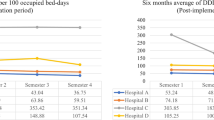Abstract
Objective
The study objective was to evaluate the impact of a restrictive antibiotic policy, efficacy of inpatient therapeutic and prophylactic antibiotic regimens and susceptibility patterns of infecting bacteria in 2000–2004.
Setting
A 500-bed general hospital in the Czech Republic.
Method
A retrospective computerized survey of antibiotic prescribing practices over a five-year period 2000–2004, using medical records and laboratory data from the hospital information system (HIS).
Main outcome measure
Consumption of antibiotics expressed in defined daily doses (DDDs) and Euros per 1,000 bed days. Resistance to antibiotics, average length of hospital stay, rate of inpatients treated with antibiotics, number of nosocomial infections per 1,000 bed days, median length of hospital stay and total mortality.
Results
Due to a restrictive antibiotic policy implemented in 2002, the use of several antibiotics in 2003 was significantly reduced but the consumption of several other antibiotics rose in 2003. In comparison with 2001 the cost of antibiotic agents (in € per 1,000 inpatient days) fell significantly by 31% in 2003 (€ 969.07 vs. € 671.34). The hospital saved about € 29,288 after the first year of implementation of the new antibiotic policy. The use of restricted antibiotics increased by 8%; however, the expenditure decreased by 26%. For non-restricted antibiotics, the use and expenditure decreased by 71% and 41%, respectively. Consequently, a net reduction of 55% (€ 804.36 vs. € 359.36) was achieved.
Conclusion
The intervention was effective in reducing the use and cost of antibiotics. The HIS is a helpful tool for observing and evaluating the impacts of the measures taken and can be used for assessment of pharmacotherapy outcomes.



Similar content being viewed by others
References
Wilton P, Smith R, Coast J, Millar M. Strategies to contain the emergence of antimicrobial resistance: a systematic review of effectiveness and cost-effectiveness. J Health Serv Res Policy 2002;7:111–7.
Adu A, Simpson JM, Armour CL. Attitudes of pharmacists and physicians to antibiotic policies in hospitals. J Clin Pharm Ther 1999;24:181–9
Struelens MJ, Byl B, Vincent JL. Antibiotic policy: a tool for controlling resistance of hospital pathogens. Clin Microbiol Infect 1999;5 Suppl 1:S19–24
Isenberg HD. Clinical microbiology procedures handbook. Washington, DC: ASM Press; 2004.
Krieg NR, Holt JG, et al. editors. Bergey’s manual of systematic bacteriology, vol 1. Baltimore: The Williams and Wilkins Co., 1994.
National Committee for Clinical Laboratory Standards. Performance standards for antimicrobial susceptibility testing. Twelfth informational supplement. NCCLS document M100-S12. Pennsylvania, USA: NCCLS, Wayne, 2002.
Kolar M, Latal T. Implementation of a practical antibiotic policy in the Czech Republic. Infect Control Hosp Epidemiol 1999;20:440–43.
Gyssens IC, Blok WL, van den Broek PJ, Hekster YA, van der Meer JW. Implementation of an educational program and an antibiotic order form to optimize quality of antimicrobial drug use in a department of internal medicine. Eur J Clin Microbiol Infect Dis 1997;16:904–12.
Geissler A, Gerbeaux P, Granier I, Blanc P, Facon K, Durand-Gasselin J. Rational use of antibiotics in the intensive care unit: impact on microbial resistance and costs. Intensive Care Med 2003;29:49–54.
Leverstein-van Hall MA, Fluit AC, Blok HE, Box AT, Peters ED, Weersink AJ, Verhoef J. Control of nosocomial multiresistant Enterobacteriaceae using a temporary restrictive antibiotic agent policy. Eur J Clin Microbiol Infect Dis 2001;20(11):785–91.
Sturm AW. Effects of a restrictive antibiotic policy on clinical efficacy of antibiotics and susceptibility patterns of organisms. Eur J Clin Microbiol Infect Dis 1990;9:381–9.
Berild D, Ringertz SH, Lelek M, Fosse B. Antibiotic guidelines lead to reductions in the use and cost of antibiotics in a university hospital. Scand J Infect Dis 2001;33:63–7.
Feucht CL, Rice LB. An interventional program to improve antibiotic use. Ann Pharmacother 2003;37:646–51.
Bassetti M, Di Biagio A, Rebesco B, Amalfitano ME, Topal J, Bassetti D. The effect of formulary restriction in the use of antibiotics in an Italian hospital. Eur J Clin Pharmacol 2001;57:529–34.
Gyssens IC, Geerligs IE, Dony JM, van der Vliet JA, van Kampen A, van den Broek PJ, Hekster YA, van der Meer JW. Optimising antimicrobial drug use in surgery: an intervention study in a Dutch university hospital. J Antimicrob Chemother 1996;38:1001–12.
Kolar M, Urbanek K, Latal T. Antibiotic selective pressure and development of bacterial resistance. Int J Antimicrob Agents 2001;17:357–63.
Lee J, Carlson JA, Chamberlain MA. A team approach to hospital formulary replacement. Diagn Microbiol Infect Dis 1995;22:239–42.
Mol PG, Wieringa JE, Nannanpanday PV, Gans RO, Degener JE, Laseur M, Haaijer-Ruskamp FM. Improving compliance with hospital antibiotic guidelines: a time-series intervention analysis. J Antimicrob Chemother 2005;55:550–57.
Acknowledgements
We like to thank all of the health-care professionals who participated in this study. The study was funded by the Breclav Hospital.
Author information
Authors and Affiliations
Corresponding author
Additional information
Rene Mach is deceased
Rights and permissions
About this article
Cite this article
Mach, R., Vlcek, J., Prusova, M. et al. Impact of a multidisciplinary approach on antibiotic consumption, cost and microbial resistance in a Czech hospital. Pharm World Sci 29, 565–572 (2007). https://doi.org/10.1007/s11096-006-9059-x
Received:
Accepted:
Published:
Issue Date:
DOI: https://doi.org/10.1007/s11096-006-9059-x




